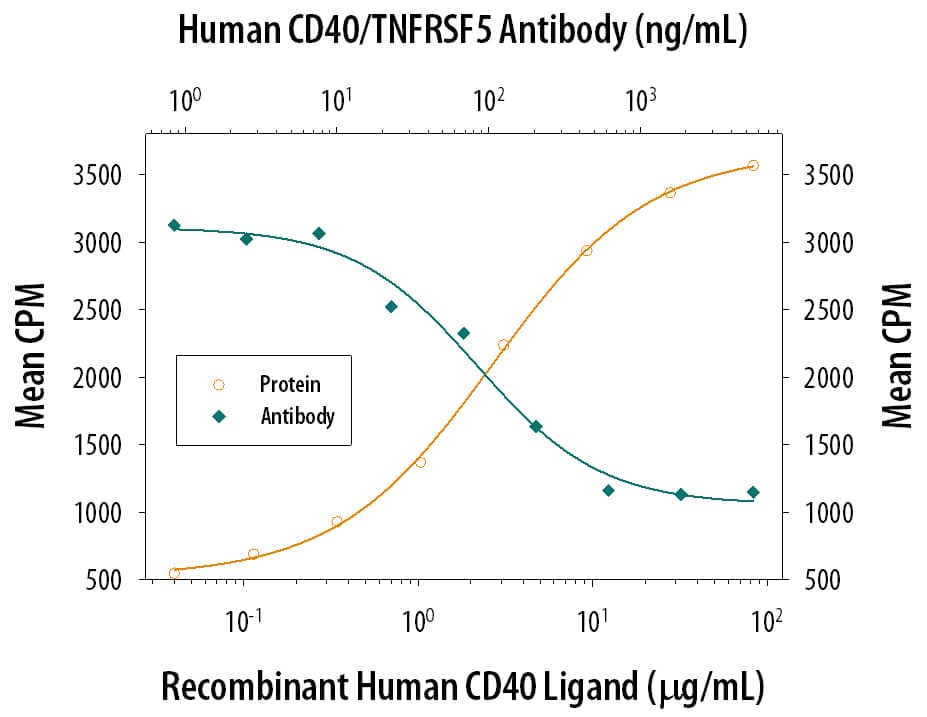Human CD40/TNFRSF5 Antibody
R&D Systems, part of Bio-Techne | Catalog # MAB6322

Key Product Details
Species Reactivity
Validated:
Cited:
Applications
Validated:
Cited:
Label
Antibody Source
Product Specifications
Immunogen
Glu21-Arg193
Accession # P25942
Specificity
Clonality
Host
Isotype
Endotoxin Level
Scientific Data Images for Human CD40/TNFRSF5 Antibody
Cell Proliferation Induced by CD40 Ligand/TNFSF5 and Neutralization by Human CD40/TNFRSF5 Antibody.
In the presence of Recombinant Human IL-4 (Catalog # 204-IL), Recombinant Human CD40 Ligand/TNFSF5 (Catalog # 6245-CL) stimulates proliferation in human B cell enriched peripheral blood mononuclear cells (PBMC) in a dose-dependent manner (orange line). Proliferation elicited by Recombinant Human CD40 Ligand/TNFSF5 (10 µg/mL) is neutralized (green line) by increasing concentrations of Human CD40/TNFRSF5 Monoclonal Antibody (Catalog # MAB6322). At 5 µg/mL, this anti-hCD40 antibody will neutralize approximately 80% of Recombinant Human CD40 Ligand/TNFSF5 -induced proliferation in the presence of Recombinant Human IL-4 (20 ng/mL).Detection of CD40/TNFRSF5 Mouse by Western Blot.
Western blot shows lysates of human spleen tissue. PVDF membrane was probed with 2 µg/mL of Mouse Anti-Human CD40/TNFRSF5 Monoclonal Antibody (Catalog # MAB6322) followed by HRP-conjugated Anti-Mouse IgG Secondary Antibody (Catalog # HAF007). A specific band was detected for CD40/TNFRSF5 at approximately 40 kDa (as indicated). This experiment was conducted under non-reducing conditions and using Immunoblot Buffer Group 1.Applications for Human CD40/TNFRSF5 Antibody
Western Blot
Sample: Human spleen tissue under non-reducing conditions
Neutralization
Measured by its ability to neutralize CD40 Ligand/TNFSF5-induced proliferation in human B cell enriched peripheral blood mononuclear cells (PBMC). At 5 µg/mL, this anti-hCD40 antibody will neutralize approximately 80% of 10 µg/mL Recombinant Human CD40 Ligand/TNFSF5 -induced proliferation of human B-cell enriched PBMCs.
Formulation, Preparation, and Storage
Purification
Reconstitution
Formulation
Shipping
Stability & Storage
- 12 months from date of receipt, -20 to -70 °C as supplied.
- 1 month, 2 to 8 °C under sterile conditions after reconstitution.
- 6 months, -20 to -70 °C under sterile conditions after reconstitution.
Background: CD40/TNFRSF5
CD40 is a type I transmembrane glycoprotein belonging to the TNF receptor superfamily. Mature human CD40 consists of a 172 amino acid (aa) extracellular domain, a 22 aa transmembrane region and a 62 aa cytoplasmic domain (1). Human and mouse CD40 share 62% aa identity. CD40 is expressed in B cells, follicular dendritic cells, dendritic cells, activated monocytes, macrophages, endothelial cells, vascular smooth muscle cells, and several tumor cell lines (2). The extracellular domain has the cysteine-rich repeat regions, which are characteristic for many of the receptors of the TNF superfamily. Interaction of CD40 with its ligand, CD40L, leads to aggregation of CD40 molecules, which in turn interact with cytoplasmic components to initiate signaling pathways. Early studies on the CD40-CD40L system revealed its role in humoral immunity. Interaction between CD40L on T cells and CD40 on B cells stimulated B cell proliferation and provided the signal for immunoglobulin isotype switching (3). Mutations in the CD40L gene, which resulted in a CD40L molecule unable to interact with CD40, are responsible for the hyper-IgM syndrome (4). Cross-linking of CD40 with antibodies or by CD40 binding to CD40L produces cell type-specific responses which include costimulation and induction of proliferation, induction of cytokine production, rescue from apoptosis, and upregulation of adhesion molecules (5). Some of the early events of intracellular signaling by the CD40-CD40L system include the association of the CD40 with TRAFs and the activation of various kinases (6-8).
References
- Torres, R.M. and E.A. Clark (1992) J. Immunol. 148:620.
- Schonbeck, U. et al. (1997) J. Biol. Chem. 272:19569.
- Armitage, R.J. et al. (1993) J. Immunol. 150:3671.
- Callard, R.E. et al. (1993) Immunol. Today 14:559.
- Stout, R.D. and J. Suttles (1996) Immunol. Today 17:487.
- Pullen, S.S. et al. (1999) Biochemistry 38:10168.
- Faris, M. et al. (1994) J. Exp. Med. 179:1923.
- Hanissian, S.H. and R.S Geha (1997) Immunity 6:379.
Alternate Names
Gene Symbol
UniProt
Additional CD40/TNFRSF5 Products
Product Documents for Human CD40/TNFRSF5 Antibody
Product Specific Notices for Human CD40/TNFRSF5 Antibody
For research use only

